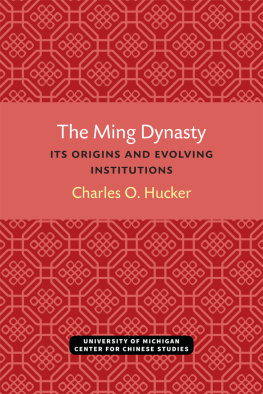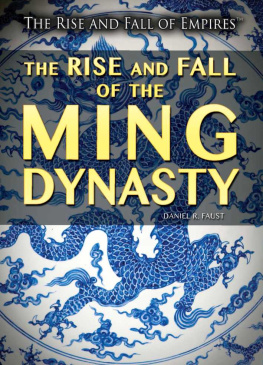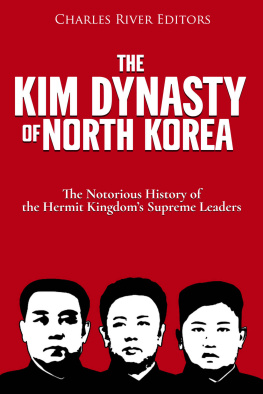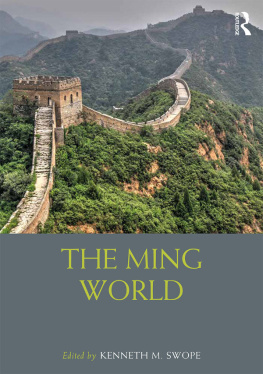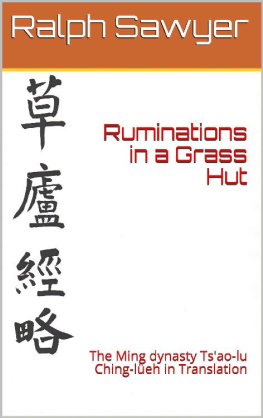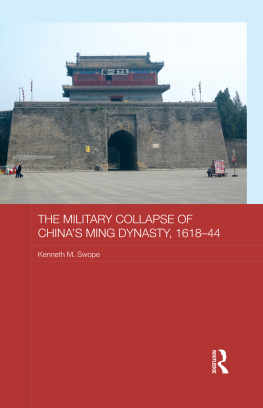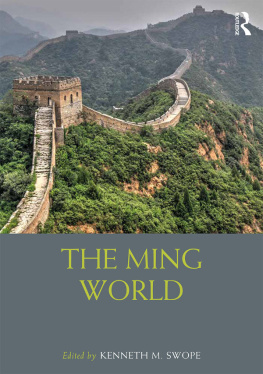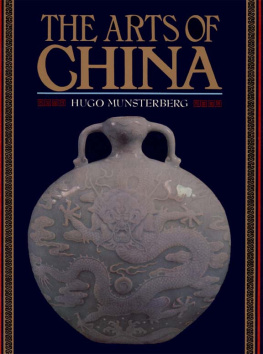Charles O. Hucker - The Ming Dynasty its Origins and Evolving Institutions
Here you can read online Charles O. Hucker - The Ming Dynasty its Origins and Evolving Institutions full text of the book (entire story) in english for free. Download pdf and epub, get meaning, cover and reviews about this ebook. year: 2020, publisher: Kenneth G. Lieberthal and Richard H. Rogel Center for Chinese Studies, genre: Art. Description of the work, (preface) as well as reviews are available. Best literature library LitArk.com created for fans of good reading and offers a wide selection of genres:
Romance novel
Science fiction
Adventure
Detective
Science
History
Home and family
Prose
Art
Politics
Computer
Non-fiction
Religion
Business
Children
Humor
Choose a favorite category and find really read worthwhile books. Enjoy immersion in the world of imagination, feel the emotions of the characters or learn something new for yourself, make an fascinating discovery.
- Book:The Ming Dynasty its Origins and Evolving Institutions
- Author:
- Publisher:Kenneth G. Lieberthal and Richard H. Rogel Center for Chinese Studies
- Genre:
- Year:2020
- Rating:4 / 5
- Favourites:Add to favourites
- Your mark:
- 80
- 1
- 2
- 3
- 4
- 5
The Ming Dynasty its Origins and Evolving Institutions: summary, description and annotation
We offer to read an annotation, description, summary or preface (depends on what the author of the book "The Ming Dynasty its Origins and Evolving Institutions" wrote himself). If you haven't found the necessary information about the book — write in the comments, we will try to find it.
The Ming Dynasty its Origins and Evolving Institutions — read online for free the complete book (whole text) full work
Below is the text of the book, divided by pages. System saving the place of the last page read, allows you to conveniently read the book "The Ming Dynasty its Origins and Evolving Institutions" online for free, without having to search again every time where you left off. Put a bookmark, and you can go to the page where you finished reading at any time.
Font size:
Interval:
Bookmark:

THE UNIVERSITY OF MICHIGAN CENTER FOR CHINESE STUDIES
MICHIGAN PAPERS IN CHINESE STUDIES
NO. 34
THE MING DYNASTY ITS ORIGINS AND EVOLVING INSTITUTIONS
by
Charles O. Hucker
Ann Arbor
Center for Chinese Studies
The University of Michigan
1978
Open access edition funded by the National Endowment for the Humanities/Andrew W. Mellon Foundation Humanities Open Book Program.
Copyright 1978
by
Charles O. Hucker
Published by
Center for Chinese Studies
The University of Michigan
Library of Congress Cataloging in Publication Data
Hucker, Charles O.
The Ming dynasty, its origins and evolving institutions.
(Michigan papers in Chinese studies; no. 34)
Includes bibliographical references.
1. ChinaHistoryMing dynasty, 1368-1644. I. Title.
II. Series.
DS753.H829 951.026 78-17354
ISBN 0-89264-034-0
Printed in the United States of America
ISBN 978-0-89264-034-8 (hardcover)
ISBN 978-0-472-03812-1 (paper)
ISBN 978-0-472-12758-0 (ebook)
ISBN 978-0-472-90153-1 (open access)
The text of this book is licensed under a Creative Commons Attribution-NonCommercial-NoDerivatives 4.0 International License: https://creativecommons.org/licenses/by-nc-nd/4.0/
CONTENTS
This long essay was written in 1970 to fit into an outline of what was then planned to be Volume IV of The Cambridge History of China, edited by Professors Denis Twitchett and John K. Fairbank. Unfortunately, publication of all portions of the history has been long postponed, and it appears that the Ming volume (or volumes) may not be available for several more years. Moreover, plans have been so altered that my contribution is not likely to fit the new Ming outline without substantial rearrangement and revision. I am nevertheless persuaded that the original effort has sufficient validity and integrity to deserve independent preservation. It is therefore issued belatedly in this series. The Center for Chinese Studies and I are grateful to the Syndics of the Cambridge University Press for allowing it to be so issued without relinquishing their proprietary rights.
Guidelines for contributors to the Cambridge History account for some characteristics of the presentation. It is offered in the form of an essay rather than a research monograph; it is not technical in style, and it is annotated only minimally. It strives for factual accuracy and clarity without unreasonable oversimplification, but it does not shrink from distinctively personal interpretations and judgments.
I am surprised and gratified that the passage of seven years, in which the volume of scholarly work on Ming China has grown enormously, has not significantly altered my 1970 interpretations and judgments. For useful criticisms of the original draft I am deeply indebted to many colleagues in the Ming studies field, most notably Professors F. W. Mote, John Dardess, Lo Jung-pang, L. Carrington Goodrich, and Ray Huang. I have perhaps not benefitted fully from all their suggestions, but I have attempted to rectify all factual errors that they have called to my attention. Otherwise, the essay is presented substantially in its 1970 form. For whatever errors may remain, and for all matters of organization and interpretation, I accept full responsibility.
Rather than attempt to update what was always meager annotation, I offer the Notes in their original form. I cannot fail to point out, however, that almost every section of this work can now be examined from a biographical point of view in the monumental Dictionary of Ming Biography, edited by L. Carrington Goodrich (2 volumes; New York: Columbia University Press, 1976). Also, some of the unpublished manuscripts cited in the Notes are now available, in some cases revised, in published form: for example, Romeyn Taylors Basic Annals of Ming Tai-tsu (San Francisco: Chinese Materials Center, 1975) and Edward L. Farmers Early Ming Government: The Evolution of Dual Capitals (Cambridge: Harvard University Press, 1976).
Charles O. Hucker
Ann Arbor, Michigan
August 1977
In the latter half of the fourteenth century, when at the opposite end of the Eurasian continent the stage was not yet set for the emergence of modern nation-states, the Chinese drove out their Mongol overlords, inaugurated a new native dynasty called Ming (13681644), and reasserted mastery of their national destiny. It was a dramatic era of change, the full significance of which can only be perceived retrospectively.
The conquest by the Mongols and their century-long military occupation had been an unprecedented shock for the Chinese, despite their long experience of fighting off or, alternatively, accommodating northern invaders. Never before had all Chinese been subjugated by aliens, and never before had leadership roles in China been so thoroughly preempted by outsiders as was the case with the Mongols and their non-Chinese hangers-on. The natural leaders of Chinas traditional society, the educated landowners, had been partly killed off in the conquest. Survivors and would-be successors had been either drawn into collaboration with the conquerors for profit or from confused conceptions of loyalty, or driven into apolitical eremitism and dilettantism. In either case, their potentiality as leaders of rebellion withered. The consequence was that Chinas recovery, when it came, was equally unprecedented, in that it was led, as it were by default, by men of the lowest social classes devoid of roots in the traditional high culture. This circumstance lent to the recovery process much of its drama and significance. It is noteworthy that Chinas recovery was also sudden and decisive and that it brought into being a new-style state system that would endure into the twentieth century and shape the style of Chinas eventual efforts to cope with modernization in the dynamically evolving Western mode.
Small-scale popular uprisings had been endemic throughout the Mongols Yan dynasty (12601368), but these were phenomena that were common in all periods of Chinas imperial history, part of the danger-filled and violence-prone normalcy that characterized the traditional Chinese society and polity. It was not until 1351 that the Mongols confident grip on China began to slip ominously. Then, disintegration of the empire came swiftly. By 1358 rebels controlled the whole Yangtze River, from modern Szechwan province in the west to the sea in the east, as well as the whole east coast from Shantung province in the north to Fukien province in the south; and North China rebels had even raided and burned the Mongols summer capital, Shang-tu in modern Chahar province (the fabled Xanadu), far beyond the Great Wall. For another decade rebels in central China struggled among themselves for supremacy while the Yan government at modern Peking stood by distractedly. When issues were resolved in the south and a consolidated revolutionary movement turned its forces northward in 1368, Mongol resistance collapsed almost totally and the last, Yan emperor fled in confusion to the steppes. The Mongol domain in China vanished, so to speak, in one swoop.
The decisiveness of the Chinese victory over the northern nomads was not wholly appreciated by the founders of the Ming dynasty. Mop-up military operations within and outside China proper persisted for sixty years; and both the later Ming emperors and their Ching dynasty (16441912) successors repeatedly contended with potential or real Mongol threats on the northern and western frontiers, down into the eighteenth century. Indeed, it was new non-Chinese overlords from the north who replaced the Ming dynasty in 1644, but the Manchu founders of the Ching dynasty were not nomadic enemies of the Chinese way of life. They had profited from a long and unresisting discipleship in Chinese culture and statecraft before they came to power in China, and they proposed no alternative to the tradition. Rather, they adopted and exalted traditional Chinese civilization with zealperhaps unfortunately so, since they ultimately became its rigid defenders when new times demanded changes. It is therefore clear from todays perspective that the Chinese way of life after 1368 was not seriously challengeable by the northerners who had shadowed all its previous history, and the tension between farmer and nomad was no longer a major theme in Chinese history.
Font size:
Interval:
Bookmark:
Similar books «The Ming Dynasty its Origins and Evolving Institutions»
Look at similar books to The Ming Dynasty its Origins and Evolving Institutions. We have selected literature similar in name and meaning in the hope of providing readers with more options to find new, interesting, not yet read works.
Discussion, reviews of the book The Ming Dynasty its Origins and Evolving Institutions and just readers' own opinions. Leave your comments, write what you think about the work, its meaning or the main characters. Specify what exactly you liked and what you didn't like, and why you think so.

